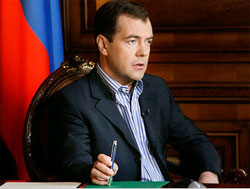Expand SDR basket to include yuan, gold: Russia
16 Jun 2009
 Russian President Dmitry Medvedev has called upon the International Monetary Fund (IMF) to expand the currency basket of Special Drawing Rights to include the Chinese yuan, commodity currencies and gold in order that it matures into a reserve currency.
Russian President Dmitry Medvedev has called upon the International Monetary Fund (IMF) to expand the currency basket of Special Drawing Rights to include the Chinese yuan, commodity currencies and gold in order that it matures into a reserve currency.
He said the neither the dollar nor any other convertible currency has performed its function as a reserve and there is a need to create a new supranational currency.
"We are likely to witness the creation of a supranational reserve currency, which will be used for international settlements," Medvedev told reorters, adding, volumes may initially be limited.
The SDR is an IMF reserve asset allocated to member countries and its exchange rate is determined by a basket of currencies that include dollar, euro, yen and sterling.
IMF is expected to review the basket in November 2010.
"The rouble and yuan deserve to be included in the SDR basket," Russian economy minister Arkady Dvorkovich told a news conference ahead of the first summit of Brazil, Russia, India and China (BRIC), in Yekaterinburg, Russia.
"It is important that the composition of the basket also reflects the role of commodities in the global economy," Dvorkovich said, naming Australian and Canadian dollars as possible candidates.
"We also think that gold has a potential as a possible participant. The price of gold has a negative correlation to the dollar. Therefore it is beneficial to tie these two instruments into one so that investors feel safer," he said.
Dvorkovich, however, did not confirm whether the rouble will be a freely floating currency by next year when the IMF reviews its SDR basket.
He said BRIC leaders will discuss new reserve currencies at the summit but said he was not for burrying the dollar as it won't serve any purpose.
Russia, last week, had threatened to cut the share of US treasuries in its forex reserves in favour of IMF bonds and bank deposits.
Finance minister Alexei Kudrin, however, said the dollar's status as the world's main reserve currency is unlikely to change in the near term.
He, however, said BRIC leaders will discuss ways of investing their reserves - among the largest in the world - in each other's currencies, through bilateral settlements and currency swaps.
"It would make sense for us if our partners agreed to place some of their reserves in Russian roubles," Dvorkovich said.
He said BRIC countries had a common position regarding the reform of the International Monetary. "Any expansion of the IMF's resource base implies strengthening of SDRs' role in the international currency system," Dvorkovich said.
Russia also is planning to shift its reserves from dollars to bonds issued by China, India and Brazil if these countries reciprocate the move, he said.
Russia had already pledged to buy $10 billion worth of IMF bonds - its first-ever - to help it raise funds for lending to countries hard hit by the global economic crisis.
But, for this, he said the IMF should revise the basket of currencies used to value its financial products to include the Russian ruble and the Chinese yuan.
Dvorkovich insisted that none of the Russian proposals were targeted at undermining the dollar. There may also be a conflict of interest here with China, which has the largest holding of US securities outside the US.
Today, the SDR has only limited use as a reserve asset, and its main function is to serve as the unit of account of the IMF and some other international organisations. The SDR is neither a currency, nor a claim on the IMF. Rather, it is a potential claim on the freely usable currencies of IMF members. Holders of SDRs can obtain these currencies in exchange for their SDRs either through the arrangement of voluntary exchanges between members or by the IMF designating members with strong external positions to purchase SDRs from members with weak external positions.
The value of the SDR was initially defined as equivalent to 0.888671 gm of fine gold - which, at the time, was also equivalent to one US dollar. After the collapse of the Bretton Woods system in 1973, however, the SDR was redefined as a basket of currencies, now consisting of the euro, the Japanese yen, pound sterling, and US dollar. The US dollar-value of the SDR is posted daily on the IMF's website. It is calculated as the sum of specific amounts of the four currencies valued in US dollars, on the basis of exchange rates quoted at noon each day in the London market.
The basket composition is reviewed every five years to ensure that it reflects the relative importance of currencies in the world's trading and financial systems. In the most recent review in November 2005, the weights of the currencies in the SDR basket were revised based on the value of the exports of goods and services and the amount of reserves denominated in the respective currencies which were held by other members of the IMF. These changes became effective on January 1, 2006. The next review by the Executive Board will take place in late 2010.





















